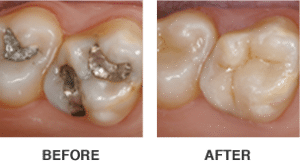While the quick and easy answer to this commonly asked question is 10 years, it turns out the answer may be a bit more complicated. Keep reading to learn more about how long fillings last. We’ll also give you some tips on how to get the longest life out of the investment you made in your fillings.
Your dentist uses dental fillings to repair any cavities, cracks, or chips in your teeth. The type of filling you and your dentist choose determines how long you can count on your filling lasting.
Table of Contents
How Long Do the Different Kinds of Fillings Last?
The kind of filling you will live with for the next 10-20 years is determined by:
- The location and amount of tooth decay around where the filling needs to go
- The cost of filling material
- Your insurance coverage
- Your dentist’s expert opinion
Here are some of the options and their average lifespans:
Silver Amalgam “Mercury” Fillings
Silver amalgam fillings typically last 15 years. It’s a mixture of silver and some other metals like tin alloy, copper, and elemental mercury. Silver amalgam fillings are durable and popular because they’re less expensive than gold or ceramic fillings. While price and durability make this option attractive, the risks of mercury toxicity have made this option far less desirable.
Gold Fillings
Gold is durable and lasts the longest of the filling materials, but is also the most expensive. Expect gold fillings to last up to 20 years according to the American Dental Association. Gold fillings tend to be stronger and can better withstand chewing forces than other fillings.
Composite Fillings
Don’t want a mouth full of metal? Many people choose composite fillings made of plastic resin because they can be matched to your natural tooth color. Composite fillings last an average of 7 years.
Porcelain (CEREC) Fillings

Porcelain fillings are also sometimes called porcelain inlays or onlays, depending on how they’re used to repair your teeth. This more durable ceramic porcelain filling can last up to 20 years, depending on how well you take care of them. Clients choose porcelain fillings because the advanced CAD/CAM CEREC technology allows these fillings to be perfectly matched and fitted to your teeth in one visit.
What Else Impacts How Long Your Fillings Last?
Do you have a cavity because you haven’t kept up with your brushing and flossing? Or maybe you cracked a tooth, grinding away your life stress as you sleep at night. The circumstances under which you came to need a filling can determine both the right type of filling for you and its lifespan. If you have any of the following, you may be returning for a filling replacement sooner than expected:
- Trauma or injury to your tooth (like getting hit in the mouth and cracking your tooth)
- Grinding your teeth while you sleep
- Poor dental hygiene
- Decay around the filling
- Biting your nails
- Your eating habits
How Does What I Eat Put My Fillings at Risk?
Many of the same foods and eating habits that are bad for your teeth are also bad for your fillings. After you eat a sugary snack or meal, the sugars cause the bacteria in your mouth to release acids that attack the tooth’s enamel. When the enamel breaks down, cavities can develop. The more tooth decay and bacteria in your mouth, the more likely your tooth will start to rot, and the filling may fall out, crack, or become painful.
Limiting sugary drinks and candy can go a long way to protect your investment in your fillings. Sticky, sour candies (like Sour Patch Kids) are some of the worst offenders because not only do they stick to your outside tooth enamel, but the acids used for the sour flavoring also harm your teeth.
Sugary soda also delivers high doses of sugar to any cavity-causing bacteria in your mouth, but also dries out your mouth, and can be acidic as well. A dry mouth is bad for your teeth and fillings because saliva helps to wash away food particles and prevents food from sticking to your teeth.
Protect your teeth and fillings by washing your mouth out with water after eating candy, drink soda with a straw if you can’t cut it out altogether, and try to limit snacking in between meals. It’s better for your teeth if you eat 3 meals a day instead of having 7 to 10 snacks. If you do need to snack between meals, choose foods that do not contain sugar.
How You Can Help Your Fillings Last Longer
If any of the list items above hit a little too close to home, don’t worry, you might not have to be taking up residence in a dental chair for regular filling replacements (called restorations) anytime soon. There are steps you can take to extend the lifespan of your fillings:
- See your dentist regularly for cleanings and to check on your fillings (every 6 months).
- Brush and floss regularly (at least twice a day) and be sure to use fluoride toothpaste.
- Avoid chewing on hard candy or ice.
- Avoid using your teeth as tools to open, rip, or tear.
- Wear a nightguard if you clench or grind your teeth at night.
- Stop biting your nails.
When Should You See Your Dentist to Check on Your Fillings?
Whether you start feeling an ache in your tooth with chewing or hear a crack while chewing it’s not always clear when you need to have your dentist check your fillings. Here are some tell-tale signs to watch for:
- Pain around your filling or a toothache
- Sensitivity to hot or cold foods or liquids
- Food getting stuck around or in your filling
- Your filling falls out in your mouth
- Your tooth feels like it has a hole or a gap in it
- Black or brown spots or lines around the edge of your filling
A repaired tooth with a filling is at greater risk for plaque build-up and tooth decay. If a filling starts to fall apart, it can be an invitation for more plaque-building bacteria, causing black or brown spots of tooth decay. Even if it’s not painful or uncomfortable, a damaged filling is an opportunity for dental decay to get worse in your mouth. It’s important to schedule an appointment with your dentist to check on the status of your filling as soon as you notice any kind of change.
What Are The Alternatives To Dental Fillings
There is always the option to do nothing but that will eventually lead to pain and more extensive dental therapy. If the tooth is severely damaged or there is no tooth opposing it, extraction of the tooth may be an alternative. If the tooth is cracked and the bite is strong, a dental crown may be a more suitable alternative to a dental filling. If you are traveling, in a hurry, or the prognosis of the tooth is questionable, a sedative (temporary) filling may be a good alternative to a permanent dental filling. Your dentist will discuss all the options to help you make the right choice.
No Dental Filling Lasts Forever
All good things must come to an end, and the same is true for dental fillings. No matter the material or how well you take care of your teeth, you’ll need to replace your fillings at some point. After filling reach their EOL or end-of-life, a porcelain crown or dental implant can restore the tooth/teeth needing to be restored. Seeing your dentist every six months is a great way to keep tabs on the status of your fillings so you aren’t surprised or inconvenienced by a cracked filling when you least expect it.
- Dental Implant Pros and Cons - August 26, 2023
- Receding Gums Stages - August 12, 2023
- When Is It Too Late for Gum Grafting? - July 8, 2023


